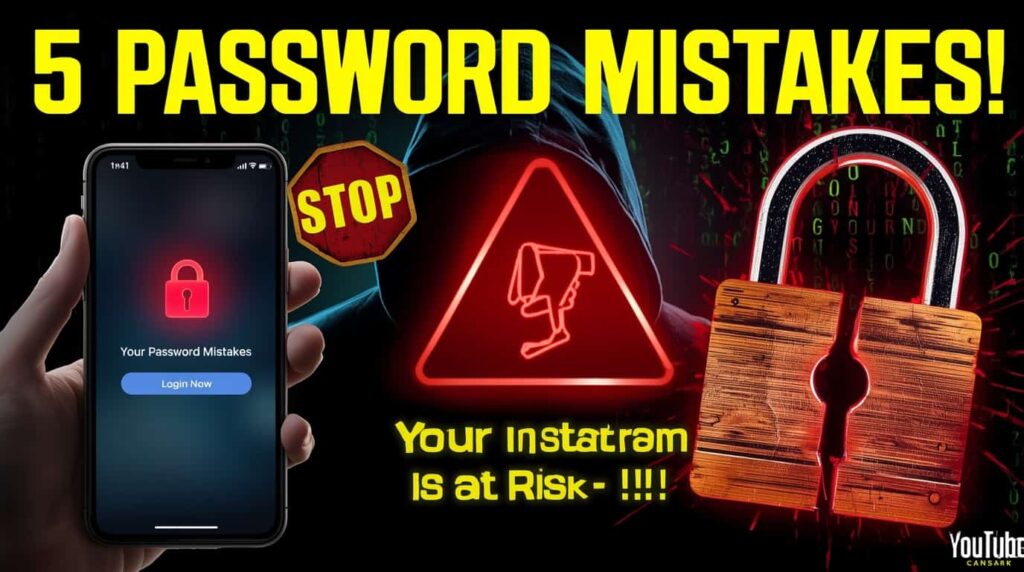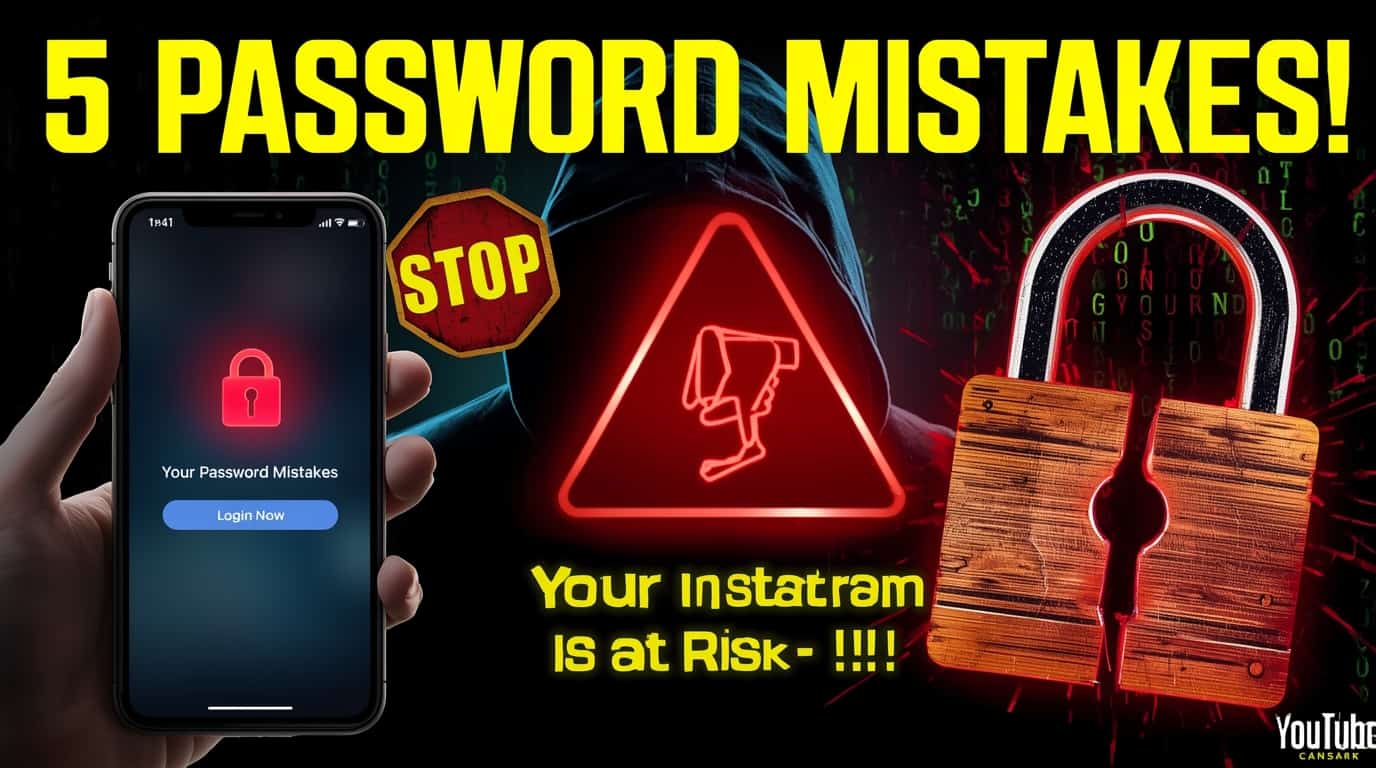Instagram isn’t just a place for sharing photos anymore — it’s where personal brands grow, businesses thrive, and communities connect. But with its popularity comes a dark side: hackers. Every day, accounts are compromised because of poor password choices and unsafe login behaviors. If you’ve ever thought, “It won’t happen to me,” think again.

A single slip — like reusing a password or ignoring two-factor authentication — could hand your account to a hacker. Fortunately, fixing these issues doesn’t take long, and once you understand the risky habits, you can easily swap them out for safer ones.
In this guide, we’ll cover the five dangerous Instagram password habits that put your account at risk. More importantly, you’ll learn Instagram account safety tips, password manager solutions, Instagram 2FA setup tricks, and real-world examples so you can protect Instagram from hackers today.
5 Password Habits That Could Put Your Instagram at Risk
Why Instagram Password Security Matters More Than Ever
- Instagram = identity + reputation. For many, it’s not just social media; it’s a portfolio, customer pipeline, and online diary.
- Hackers know this. That’s why Instagram accounts are prime targets for phishing, data theft, and scams.
- Password habits decide your fate. Even the best Instagram login protection won’t work if you use a weak or recycled password.
Think of your Instagram account like your house. You wouldn’t leave the door unlocked, give strangers a copy of your key, or write your alarm code on a sticky note. Yet, many users do the digital version of these risky moves every day.
The 5 Password Habits That Put Instagram at Risk
Let’s break down the five most common — and most dangerous — mistakes people make with their Instagram password security.
Habit 1: Using Weak or Reused Passwords
This is the #1 reason accounts get hacked. Hackers don’t need Hollywood-level skills — they often use simple tools to try leaked passwords from other sites. If you use the same weak password on multiple accounts, your Instagram could be next.
Examples of weak passwords:
- “123456”
- “password”
- Your name + birth year (like Sarah1995)
- Reused login details from an old shopping or gaming site
Why it’s risky:
- Data breaches leak millions of usernames and passwords every year.
- Hackers use automated “credential stuffing” attacks to try those leaked combos across Instagram.
- If your Instagram password is the same as your Netflix or old email, you’re vulnerable.
How to fix it:
- Create a unique password just for Instagram.
- Use at least 12–16 characters with a mix of uppercase, lowercase, numbers, and symbols.
- Consider a password manager for Instagram like Bitwarden, LastPass, or 1Password. These tools generate and store complex passwords so you don’t have to remember them.
Pro tip: A passphrase (like “Lemon!Train$Dance@47”) is stronger and easier to recall than a random jumble.
Habit 2: Sharing Your Password With Others
It may feel harmless to share your Instagram password with a friend, business partner, or social media manager, but every extra person increases your risk.
Why it’s risky:
- You lose control. Even well-meaning people might log in on unsafe devices.
- If someone else’s email gets hacked, your password could be exposed.
- In business contexts, a disgruntled partner or ex-employee could lock you out.
How to fix it:
- Never share your password directly.
- For teams or business accounts, use Instagram’s Business Manager tools to grant roles and permissions without sharing logins.
- If you must share access temporarily, change your password afterward.
Example scenario: A small business gave their intern the Instagram login. Months later, after leaving the job, the intern still had access and accidentally posted to the company page. Avoid this by assigning official admin roles.
Habit 3: Ignoring Two-Factor Authentication (2FA)
Two-factor authentication (2FA) is one of the simplest yet most powerful Instagram login protection tools available. But too many users skip it because they think it’s inconvenient.
Why it’s risky:
- Without 2FA, a password leak equals instant access for hackers.
- With 2FA, even if hackers steal your password, they need a second code from your phone or authentication app.
How to set up Instagram 2FA (step-by-step):
- Go to your profile → tap Menu (☰).
- Select Settings & privacy → Accounts Center → Password and security.
- Choose Two-factor authentication.
- Select your method:
- Authentication app (Google Authenticator, Authy) → safest option.
- SMS code → better than nothing, but vulnerable to SIM-swap attacks.
- Security key → physical device for the highest level of protection.
Extra tip: Save your backup codes in a password manager or print them and keep them safe.
Real-world example: A lifestyle blogger fell for a phishing scam and lost her Instagram password. Luckily, she had Instagram 2FA setup with an authenticator app. The hacker couldn’t bypass the second step, and she recovered her account in minutes.
Habit 4: Saving Passwords on Public or Shared Devices
Have you ever logged into Instagram from a library computer, a friend’s laptop, or a hotel business center and hit “Save Password”? If so, your account could still be accessible on that machine.
Why it’s risky:
- Saved passwords can be viewed by anyone who uses the device later.
- Browsers sometimes sync saved passwords across devices. If the owner’s Google account or iCloud is hacked, so are your credentials.
- Public Wi-Fi also increases risks of interception when logging in.
How to fix it:
- Never save your Instagram password on public or shared devices.
- Always log out when using a borrowed device.
- Use a password manager on your personal devices instead of browser autofill.
- Avoid logging in over unsecured public Wi-Fi unless you use a VPN.
Scenario: A student logged into Instagram on a school computer and forgot to log out. A classmate later found the open session and posted embarrassing photos. Always clear sessions and avoid saving logins outside your own devices.
Habit 5: Falling for Phishing Scams
Phishing is when attackers trick you into giving up your password by pretending to be Instagram. These scams often come via email, DMs, or fake login pages.
Common phishing tricks:
- “Your account will be suspended — click here to appeal!”
- “Congratulations, you won a creator badge!”
- A DM link that looks like Instagram but leads to a fake login page.
Why it’s risky:
- Hackers don’t need to guess your password if you hand it over willingly.
- Phishing links often look convincing, with Instagram logos and similar URLs.
How to avoid it:
- Check the sender’s email. Official Instagram emails come from @mail.instagram.com.
- Use the “Emails from Instagram” section in your app: Settings → Security → Emails from Instagram. This shows the last 14 days of official communications.
- Never log in via links from emails or DMs. Always type instagram.com manually.
- Turn on 2FA for an extra barrier, even if you slip once.
Example: A photographer clicked on a DM claiming to be an Instagram copyright notice. The fake login page stole her credentials. She only regained control after a stressful week of account recovery.
How to Build Strong Instagram Password Habits
Breaking bad habits is just half the story. Here are safer replacements:
- Unique passwords for every account.
- Use a password manager for creating and storing long, complex passwords.
- Enable Instagram 2FA setup immediately.
- Keep recovery info updated — email and phone should be secure and current.
- Review login activity regularly under Settings → Security → Login Activity.
Instagram Account Safety Tips Beyond Passwords
Password security is crucial, but don’t stop there. Protect Instagram from hackers with these extra steps:
- Check third-party app connections. Remove suspicious apps under Settings → Security → Apps and Websites.
- Update your Instagram app regularly — updates patch security flaws.
- Lock your phone with biometrics or a passcode to prevent local access.
- Stay alert on public Wi-Fi. Use a VPN or mobile data when possible.
- Back up your content. Even if your account is compromised, you’ll have your posts safe.
FAQs About Instagram Password Security
1. What is the best password for Instagram?
A strong Instagram password should be at least 12–16 characters, unique, and contain a mix of letters, numbers, and symbols. Avoid personal info like birthdays or pet names.
2. Can Instagram accounts be hacked easily?
Yes, if users rely on weak passwords, reuse logins, or ignore 2FA. Hackers often exploit phishing or data breaches rather than “guessing” passwords.
3. How can I recover my Instagram password if I forgot it?
Use the “Forgot password?” option on the login page. Instagram will send a recovery link to your registered email or phone. If those are compromised, use “Need more help?” for advanced recovery.
4. Is SMS 2FA enough to protect Instagram?
SMS 2FA is better than nothing, but authenticator apps or security keys provide stronger protection against SIM-swapping and phishing.
5. Should I use a password manager for Instagram?
Yes. A password manager helps generate and store unique, complex passwords securely. It’s safer than trying to remember them or writing them down.
6. What do I do if I get a suspicious Instagram email?
Check the sender’s domain. Official emails only come from @mail.instagram.com. You can also verify in-app under Settings → Security → Emails from Instagram.
7. How often should I change my Instagram password?
Update your password if you suspect compromise, if you shared it, or after a data breach. Otherwise, focus on using a strong, unique password with 2FA.
Conclusion: Secure Your Instagram Today
Your Instagram is more than just an app — it’s your digital identity. Weak passwords, shared logins, ignored 2FA, careless device habits, and phishing traps all open the door to hackers. But with small changes, you can slam that door shut.
Here’s your action plan:
- Change to a strong, unique Instagram password now.
- Enable Instagram 2FA setup with an authenticator app.
- Audit your devices, remove risky logins, and secure your email.
- Stay alert to phishing attempts and never click suspicious links.
Don’t wait for a hacker to teach you a costly lesson. Take five minutes today to strengthen your Instagram password security and enjoy peace of mind knowing your account is safer.

Dilip Chouhan is a passionate content creator from Rajasthan, India. At 22, he has successfully completed his graduation and is dedicated to sharing valuable knowledge and insights through his writing. With a focus on delivering informative, engaging, and reader-friendly content, Dilip aims to help his audience stay updated, inspired, and empowered.
